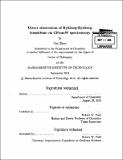| dc.contributor.advisor | Robert W. Field. | en_US |
| dc.contributor.author | Zhou, Yan, Ph. D. Massachusetts Institute of Technology | en_US |
| dc.contributor.other | Massachusetts Institute of Technology. Department of Chemistry. | en_US |
| dc.date.accessioned | 2015-01-20T17:56:46Z | |
| dc.date.available | 2015-01-20T17:56:46Z | |
| dc.date.copyright | 2014 | en_US |
| dc.date.issued | 2014 | en_US |
| dc.identifier.uri | http://hdl.handle.net/1721.1/93038 | |
| dc.description | Thesis: Ph. D., Massachusetts Institute of Technology, Department of Chemistry, 2014. | en_US |
| dc.description | Cataloged from PDF version of thesis. | en_US |
| dc.description | Includes bibliographical references (pages 295-307). | en_US |
| dc.description.abstract | Rydberg-Rydberg transitions of BaF molecules have been directly observed in our lab. The key to the experimental success is our ability to combine two powerful and new technologies, Chirped-Pulse millimeter-Wave spectroscopy (CPmmW) and a buffer gas cooled molecular beam source. CPmmW spectroscopy is a form of broadband (20 GHz bandwidth), high-resolution (50 kHz), free induction decay-detected (FID) spectroscopy with accurate relative intensities (10%), which is successfully applied to record Rydberg-Rydberg spectra of Calcium and Barium atoms. To extend CPmmW spectroscopy to a molecular system, I have constructed a new setup, a 20 K Neon buffer gas cooled molecular beam system, which generates of beam containing >1000 times more molecules and 10 times less translational velocity than a Smalleytype laser ablation supersonic beam source. Hundreds of molecular Rydberg-Rydberg transitions with high resolution and high dynamic range can now be recorded in a few hours. The success of this experiment suggests many applications in the near future, such as developing a user-friendly experimental method to study and manipulate Rydberg molecules, preparing a single molecular beam pulse that contains 108 state-selected core-nonpenetrating Rydberg molecules/molecular ions, and studying the electronic structure (dipole and quadrupole moments and polarizability) of the molecular ion core with unprecedented precision and completeness. In addition, strong collective effects (superradiance) have also been observed. | en_US |
| dc.description.statementofresponsibility | by Yan Zhou. | en_US |
| dc.format.extent | 307 pages | en_US |
| dc.language.iso | eng | en_US |
| dc.publisher | Massachusetts Institute of Technology | en_US |
| dc.rights | M.I.T. theses are protected by copyright. They may be viewed from this source for any purpose, but reproduction or distribution in any format is prohibited without written permission. See provided URL for inquiries about permission. | en_US |
| dc.rights.uri | http://dspace.mit.edu/handle/1721.1/7582 | en_US |
| dc.subject | Chemistry. | en_US |
| dc.title | Direct observation of Rydberg-Rydberg transitions via CPmmW spectroscopy | en_US |
| dc.type | Thesis | en_US |
| dc.description.degree | Ph. D. | en_US |
| dc.contributor.department | Massachusetts Institute of Technology. Department of Chemistry | |
| dc.identifier.oclc | 899243564 | en_US |
